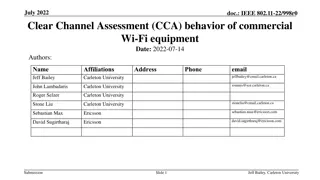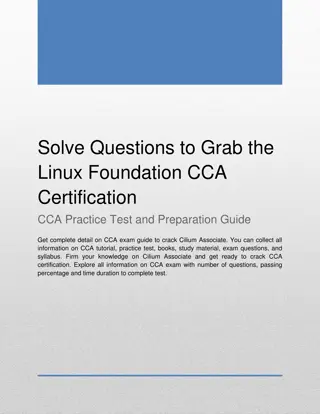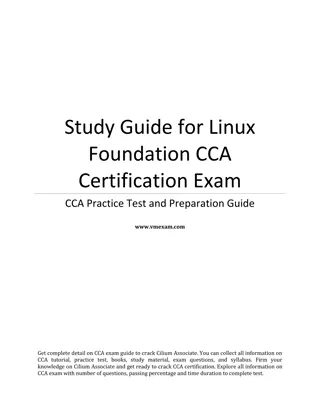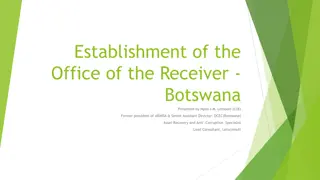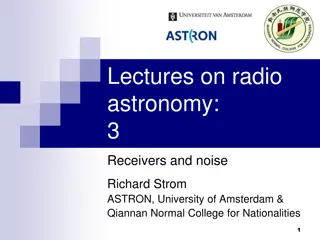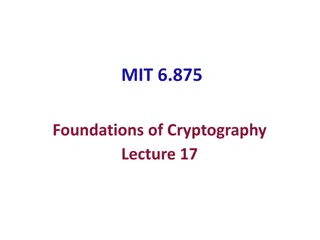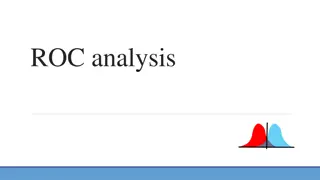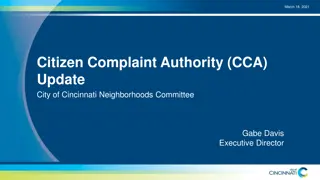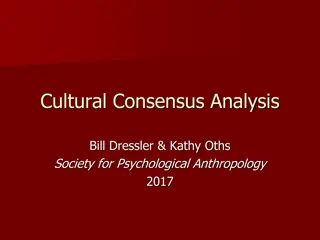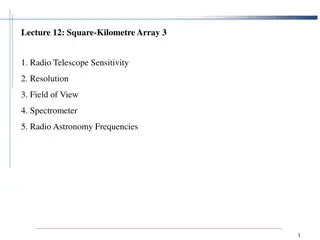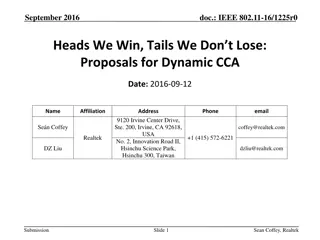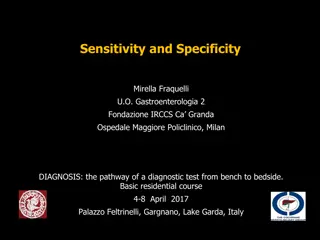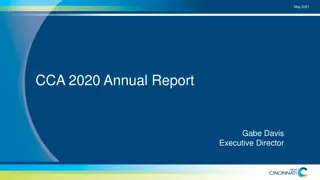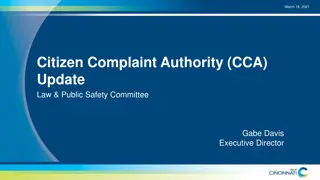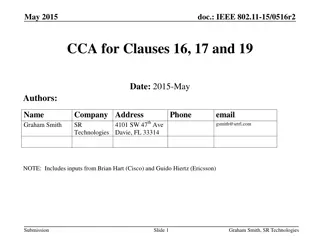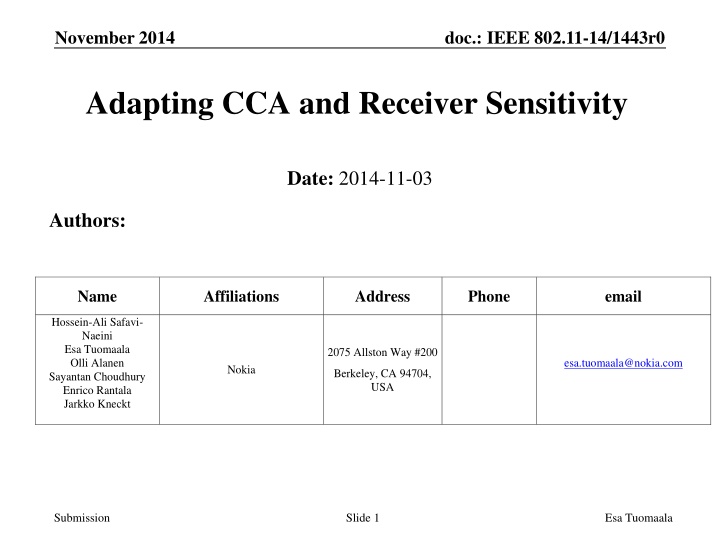
IEEE 802.11-14/1443r0: Adapting CCA and Receiver Sensitivity
"Learn about adapting Clear Channel Assessment (CCA) and receiver sensitivity in IEEE 802.11-14/1443r0 standard. Explore how modifying CCA can impact packet reception, energy detection, and throughput fairness in wireless networks. Discover strategies for improving fairness in dense deployment scenarios through parameter adjustments. Find out about adjusting parameters in managed and distributed environments for optimal network performance."
Uploaded on | 3 Views
Download Presentation

Please find below an Image/Link to download the presentation.
The content on the website is provided AS IS for your information and personal use only. It may not be sold, licensed, or shared on other websites without obtaining consent from the author. If you encounter any issues during the download, it is possible that the publisher has removed the file from their server.
You are allowed to download the files provided on this website for personal or commercial use, subject to the condition that they are used lawfully. All files are the property of their respective owners.
The content on the website is provided AS IS for your information and personal use only. It may not be sold, licensed, or shared on other websites without obtaining consent from the author.
E N D
Presentation Transcript
November 2014 doc.: IEEE 802.11-14/1443r0 Adapting CCA and Receiver Sensitivity Date: 2014-11-03 Authors: Name Affiliations Address Phone email Hossein-Ali Safavi- Naeini Esa Tuomaala Olli Alanen Sayantan Choudhury Enrico Rantala Jarkko Kneckt 2075 Allston Way #200 esa.tuomaala@nokia.com Nokia Berkeley, CA 94704, USA Submission Slide 1 Esa Tuomaala
November 2014 doc.: IEEE 802.11-14/1443r0 Background CCA/Receiver Sensitivity Threshold governing packet reception (decode NAV and deferral) More aggressive threshold governing pure energy detection Maximum threshold defined by the standard Vendors are free to have more sensitive receivers (e.g. -90dBm vs. -82 dBm) Modifying CCA has shown various levels of gain [1-6] Uniform thresholds have shown mixed results Adaptive thresholds proposed in [7] Submission Slide 2 Esa Tuomaala
November 2014 doc.: IEEE 802.11-14/1443r0 This Contribution Scenario 1 simulations shown with varying receiver sensitivities Demonstrating the unfairness in per-floor throughput Impact of local adaptation of thresholds (per-floor basis) Submission Slide 3 Esa Tuomaala
November 2014 doc.: IEEE 802.11-14/1443r0 Contention Domains -82dBm Relative size of contention domains affects throughput More contention for crowded areas Less contention in certain spots (e.g. building edges) Easily observed in the 11ax scenarios (e.g. Scenario 1) Submission Slide 4 Esa Tuomaala
November 2014 doc.: IEEE 802.11-14/1443r0 Improving Fairness In a dense deployment, not all STAs/APs experience the same conditions Multiple parameters could be adjusted to improve fairness EDCA parameters: adjust contention window, TXOP duration, etc CCA/Receiver Sensitivity/Color bit: shrink deferral radius The above parameters can be optimized to improve spatial reuse while maintaining fairness Submission Slide 5 Esa Tuomaala
November 2014 doc.: IEEE 802.11-14/1443r0 Adjusting Parameters Centralized Feasible in managed environments (e.g. corporate setting) Can arrive at a better solution according to given metrics (e.g. 5% throughput) Distributed Using beacons or inter-AP communication to set per BSS parameters AP could assign parameters to all associated STAs (RAW concept) Hybrid approach possible (centralized in-BSS, distributed inter- BSS) Submission Slide 6 Esa Tuomaala
November 2014 doc.: IEEE 802.11-14/1443r0 Scenario 1 (Residential) : Setup Residential Scenario [8] Assumptions: 1 AP Per apartment 2 STAs per AP Uplink only traffic (full buffer AC2) Fading OFF 11ax Scenario 1 Pathloss formula AP: 21dBm, STA: 15dBm 3 m Parameters: Fixed MCS: 256QAM RTS/CTS OFF 80 MHz Channel (single channel) Max Number of AMPDUs: 64 Floor layout 10 m 10 m Submission Slide 7 Esa Tuomaala
November 2014 doc.: IEEE 802.11-14/1443r0 Scenario 1 (Residential) : Results Floor plots Average throughput per apartment over a large number of drops Each drop with random node positioning Results displayed in Kbps CDFs: Per floor throughput for all nodes in all drops Clear symmetries in floors 1,5 and 2,4 as expected Submission Slide 8 Esa Tuomaala
November 2014 doc.: IEEE 802.11-14/1443r0 Default (-90dBm) Empirical CDF Mean: 32330.46, 5th: 3746.67, 50th: 26652.00, 90th: 66782.67 4 x 10 1 Floor 1 (-90 dBm) 20 6 0.9 4 Kbps 10 0.8 2 0.7 0 0 10 Mean: 23445.57, 5th: 2960.00, 50th: 18741.33, 90th: 48629.33 20 30 40 50 60 70 80 90 100 0.6 4 x 10 Floor 2 (-90 dBm) 20 6 F(x) 0.5 floors 2-4 with worse throughput 4 Kbps 10 0.4 2 0.3 Floor 1 (-90 dBm) Floor 2 (-90 dBm) Floor 3 (-90 dBm) Floor 4 (-90 dBm) Floor 5 (-90 dBm) 0 0 10 Mean: 24836.46, 5th: 3408.00, 50th: 21014.67, 90th: 50174.67 20 30 40 50 60 70 80 90 100 0.2 4 x 10 20 6 Floor 3 (-90 dBm) 0.1 0 4 Kbps 0 1 2 3 4 5 Kbps 6 7 8 9 10 11 4 10 x 10 2 0 0 10 Mean: 23914.38, 5th: 3032.00, 50th: 19268.00, 90th: 49141.33 20 30 40 50 60 70 80 90 100 Receiver sensitivity: -90dBm Floors 1,5 get much better throughput than 2-4 Significant difference in floor throughput (unfair) 4 x 10 20 6 Floor 4 (-90 dBm) 4 Kbps 10 2 0 0 10 Mean: 31728.41, 5th: 3665.33, 50th: 25937.33, 90th: 66589.33 20 30 40 50 60 70 80 90 100 4 x 10 20 6 Floor 5 (-90 dBm) 4 Kbps 10 2 0 0 10 20 30 40 50 60 70 better throughput at edge 80 90 100 Submission Slide 9 Esa Tuomaala
November 2014 doc.: IEEE 802.11-14/1443r0 -82 dBm Empirical CDF Mean: 33310.54, 5th: 2816.00, 50th: 25986.67, 90th: 72296.00 4 x 10 1 Floor 1 (-82 dBm) 20 6 0.9 4 Kbps 10 0.8 2 0.7 0 0 10 Mean: 24994.66, 5th: 2353.33, 50th: 18478.67, 90th: 55752.00 20 30 40 50 60 70 80 90 100 0.6 4 x 10 Floor 2 (-82 dBm) 20 6 F(x) 0.5 4 Kbps 10 0.4 2 0.3 Floor 1 (-82 dBm) Floor 2 (-82 dBm) Floor 3 (-82 dBm) Floor 4 (-82 dBm) Floor 5 (-82 dBm) 0 0 10 Mean: 25774.92, 5th: 2686.67, 50th: 20080.00, 90th: 55014.67 20 30 40 50 60 70 80 90 100 worse throughput 0.2 4 x 10 20 6 Floor 3 (-82 dBm) 0.1 0 4 Kbps 0 1 2 3 4 5 Kbps 6 7 8 9 10 11 4 10 x 10 2 0 0 10 Mean: 24759.61, 5th: 2244.00, 50th: 18669.33, 90th: 54540.00 20 30 40 50 60 70 80 90 100 Receiver sensitivity: -82dBm Overall throughput is improved Floors 2-4 still receive poor throughput compared to 1,5 4 x 10 20 6 Floor 4 (-82 dBm) 4 Kbps 10 2 0 0 10 Mean: 33830.90, 5th: 2985.33, 50th: 27025.33, 90th: 72049.33 20 30 40 50 60 70 80 90 100 4 x 10 20 6 Floor 5 (-82 dBm) 4 Kbps 10 2 0 0 10 20 30 40 50 60 70 better throughput at edge 80 90 100 Submission Slide 10 Esa Tuomaala
November 2014 doc.: IEEE 802.11-14/1443r0 -72 dBm Empirical CDF Mean: 36027.55, 5th: 2504.00, 50th: 26908.00, 90th: 80460.00 4 x 10 1 Floor 1 (-72 dBm) 20 6 0.9 4 Kbps 10 0.8 2 0.7 0 0 10 Mean: 28525.87, 5th: 2049.33, 50th: 21029.33, 90th: 64773.33 20 30 40 50 60 70 80 90 100 0.6 4 x 10 Floor 2 (-72 dBm) 20 6 F(x) 0.5 4 Kbps 10 0.4 2 0.3 Floor 1 (-72 dBm) Floor 2 (-72 dBm) Floor 3 (-72 dBm) Floor 4 (-72 dBm) Floor 5 (-72 dBm) 0 0 10 Mean: 31850.44, 5th: 2766.67, 50th: 24538.67, 90th: 69408.00 20 30 40 50 60 70 80 90 100 0.2 4 x 10 20 6 Floor 3 (-72 dBm) 0.1 0 4 Kbps 0 1 2 3 4 5 Kbps 6 7 8 9 10 11 4 10 x 10 2 0 0 10 Mean: 28801.55, 5th: 2072.00, 50th: 21405.33, 90th: 64348.00 20 30 40 50 60 70 80 90 100 Receiver sensitivity: -72dBm General picture improves 4 x 10 20 6 Floor 4 (-72 dBm) 4 Kbps 10 2 0 0 10 Mean: 36195.57, 5th: 2158.67, 50th: 26914.67, 90th: 80753.33 20 30 40 50 60 70 80 90 100 4 x 10 20 6 Floor 5 (-72 dBm) 4 Kbps 10 2 0 0 10 20 30 40 50 60 70 80 90 100 Submission Slide 11 Esa Tuomaala
November 2014 doc.: IEEE 802.11-14/1443r0 -86,-65,-62,-65,-86 dBm Empirical CDF Mean: 31785.19, 5th: 3320.00, 50th: 25334.67, 90th: 67128.00 4 x 10 1 Floor 1 (-86 dBm) 20 6 0.9 4 Kbps 10 0.8 2 0.7 0 0 10 Mean: 30276.23, 5th: 1798.67, 50th: 21404.00, 90th: 70165.33 20 30 40 50 60 70 80 90 100 0.6 4 almost uniform throughput per floor (fair) x 10 Floor 2 (-65 dBm) 20 6 F(x) 0.5 4 Kbps 10 0.4 2 0.3 Floor 1 (-86 dBm) Floor 2 (-65 dBm) Floor 3 (-62 dBm) Floor 4 (-65 dBm) Floor 5 (-86 dBm) 0 0 10 Mean: 31525.27, 5th: 1797.33, 50th: 23024.00, 90th: 73062.67 20 30 40 50 60 70 80 90 100 0.2 4 x 10 20 6 Floor 3 (-62 dBm) 0.1 0 4 Kbps 0 1 2 3 4 5 Kbps 6 7 8 9 10 11 4 10 x 10 2 0 0 10 Mean: 31179.42, 5th: 1824.00, 50th: 21854.67, 90th: 72512.00 20 30 40 50 60 70 80 90 100 More fair by using per-floor thresholds No optimization done for best thresholds 5th percentile suffers on some floors 4 x 10 20 6 Floor 4 (-65 dBm) 4 Kbps 10 2 0 0 10 Mean: 31336.08, 5th: 3205.33, 50th: 24948.00, 90th: 67998.67 20 30 40 50 60 70 80 90 100 4 x 10 20 6 Floor 5 (-86 dBm) 4 Kbps 10 2 0 0 10 20 30 40 50 60 70 better throughput persists 80 90 100 Submission Slide 12 Esa Tuomaala
November 2014 doc.: IEEE 802.11-14/1443r0 Scenario 1 (Alternate Pathloss) Same as previous setup, only pathloss is modified: Floor penetration loss is 10dB per floor, wall loss remains at 5dB How scenario dependent are the thresholds? How adaptive should they be? Submission Slide 13 Esa Tuomaala
November 2014 doc.: IEEE 802.11-14/1443r0 -82 dBm (alternate PL) Empirical CDF Mean: 33881.01, 5th: 3845.33, 50th: 29986.67, 90th: 66132.00 4 x 10 1 Floor 1 (-82 dBm) 20 6 0.9 4 Kbps 10 0.8 2 0.7 0 0 10 Mean: 18835.16, 5th: 3785.33, 50th: 17648.00, 90th: 32284.00 20 30 40 50 60 70 80 90 100 0.6 4 x 10 Floor 2 (-82 dBm) 20 6 F(x) 0.5 4 Kbps 10 0.4 2 0.3 Floor 1 (-82 dBm) Floor 2 (-82 dBm) Floor 3 (-82 dBm) Floor 4 (-82 dBm) Floor 5 (-82 dBm) 0 0 10 Mean: 24515.80, 5th: 2314.67, 50th: 22626.67, 90th: 45954.67 20 30 40 50 60 70 80 90 100 0.2 4 x 10 20 6 Floor 3 (-82 dBm) 0.1 0 4 Kbps 0 1 2 3 4 5 Kbps 6 7 8 9 10 11 4 10 x 10 2 0 0 10 Mean: 18804.87, 5th: 3770.67, 50th: 18065.33, 90th: 31846.67 20 30 40 50 60 70 80 90 100 Receiver sensitivity: -82dBm Floor 3 has better throughput because floors 2,4 rarely transmit Very different results compared to prior pathloss model 4 x 10 20 6 Floor 4 (-82 dBm) 4 Kbps 10 2 0 0 10 Mean: 34295.15, 5th: 4025.33, 50th: 30424.00, 90th: 66870.67 20 30 40 50 60 70 80 90 100 4 x 10 20 6 Floor 5 (-82 dBm) 4 Kbps 10 2 0 0 10 20 30 40 50 60 70 80 90 100 Submission Slide 14 Esa Tuomaala
November 2014 doc.: IEEE 802.11-14/1443r0 -72 dBm (alternate PL) Empirical CDF Mean: 35679.37, 5th: 3150.67, 50th: 30785.33, 90th: 72736.00 4 x 10 1 Floor 1 (-72 dBm) 20 6 0.9 4 Kbps 10 0.8 2 0.7 0 0 10 Mean: 20253.89, 5th: 2930.67, 50th: 18284.00, 90th: 37412.00 20 30 40 50 60 70 80 90 100 0.6 4 x 10 Floor 2 (-72 dBm) 20 6 F(x) 0.5 4 Kbps 10 0.4 2 0.3 Floor 1 (-72 dBm) Floor 2 (-72 dBm) Floor 3 (-72 dBm) Floor 4 (-72 dBm) Floor 5 (-72 dBm) 0 0 10 Mean: 27837.03, 5th: 1778.67, 50th: 24621.33, 90th: 56140.00 20 30 40 50 60 70 80 90 100 0.2 4 x 10 20 6 Floor 3 (-72 dBm) 0.1 0 4 Kbps 0 1 2 3 4 5 Kbps 6 7 8 9 10 11 4 10 x 10 2 0 0 10 Mean: 20422.10, 5th: 3109.33, 50th: 18698.67, 90th: 37361.33 20 30 40 50 60 70 80 90 100 Receiver sensitivity: -72dBm Some improvements, but floors 2 & 4 continue to do poorly 4 x 10 20 6 Floor 4 (-72 dBm) 4 Kbps 10 2 0 0 10 Mean: 35979.57, 5th: 2930.67, 50th: 30817.33, 90th: 74036.00 20 30 40 50 60 70 80 90 100 4 x 10 20 6 Floor 5 (-72 dBm) 4 Kbps 10 2 0 0 10 20 30 40 50 60 70 80 90 100 Submission Slide 15 Esa Tuomaala
November 2014 doc.: IEEE 802.11-14/1443r0 Conclusion Fundamental Unfairness With fixed thresholds, we show that there is unfairness (based on location, interference, etc.) The unfairness can be mitigated by intelligent selection of thresholds Results are scenario dependent Results are sensitive to path loss parameters and scenario setup We show that adaptive configuration of CCA threshold or receiver sensitivity can help improve spatial reuse while maintaining fairness Submission Slide 16 Esa Tuomaala
November 2014 doc.: IEEE 802.11-14/1443r0 References [1] IEEE 802.11-14/0082r0 Improved Spatial Reuse Feasibility Part I [2] IEEE 802.11-14/0083r0 Improved Spatial Reuse Feasibility Part II [3] IEEE 802.11-14/0372r2 System Level Simulations on Increased Spatial Reuse [4] IEEE 802.11-14/846r1 Changing CCA in the Residential Environment [5] IEEE 802.11-14/861r0 Impact of CCA adaptation on spatial reuse in dense residential scenario [6] IEEE 802.11-14/0578r0 - Residential Scenario CCA/TPC Simulation Discussion [7] IEEE 802.11-14/1233r2 Adaptive CCA for 11ax [8] IEEE 802.11-14/0621r4 TGax Simulation Scenarios Submission Slide 17 Esa Tuomaala

